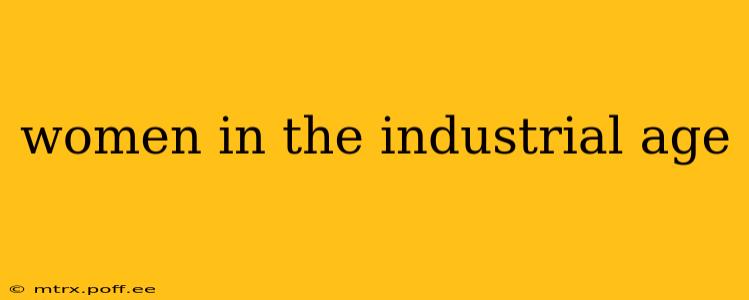The Industrial Age, spanning roughly from the late 18th to the mid-20th century, dramatically reshaped societies worldwide. While often viewed through the lens of male factory workers and industrialists, the experience of women during this period was equally transformative, albeit vastly different and often fraught with challenges. This era witnessed a significant shift in women's roles, from predominantly agrarian and domestic spheres to participation in the burgeoning factories and a growing – though still limited – entry into the professional world. This shift, however, didn't erase pre-existing inequalities; rather, it reframed them within the context of industrial capitalism.
How Did the Industrial Revolution Affect Women's Lives?
The Industrial Revolution profoundly impacted women's lives, creating both opportunities and significant hardships. The shift from rural, agrarian economies to urban, industrial centers forced many women to migrate to cities in search of work. This influx of women into urban areas created new social dynamics and challenges, particularly concerning housing, sanitation, and overall living conditions.
Factory Work: Many women found employment in factories, often performing low-skill, repetitive tasks for meager wages. Textile mills, in particular, employed a significant number of women and children. These jobs were often dangerous and unhealthy, with long hours and poor working conditions. While offering financial independence (at least to some degree), this work rarely provided women with the same pay or opportunities as men for equivalent labor.
Domestic Service: Even with the rise of factory work, domestic service remained a major source of employment for women throughout the Industrial Age. This sector encompassed a wide range of tasks, from cooking and cleaning to childcare and personal care for wealthier families. While offering relative stability, domestic service frequently involved long hours, low wages, and limited autonomy.
What Roles Did Women Play in the Industrial Age?
While factory and domestic work constituted the bulk of women's employment, it's crucial to acknowledge the diverse roles women played. The Industrial Age also saw the emergence of some new opportunities, albeit limited:
- Clerical Work: The growth of businesses and bureaucracies created a need for clerical workers, a field that gradually opened to women, although often at lower pay than their male counterparts.
- Teaching: The expansion of education created opportunities for women as teachers, particularly in primary schools. However, this profession was frequently viewed as less prestigious and lower-paying than male-dominated fields.
- Nursing: The development of modern hospitals and healthcare systems offered new avenues for women in nursing, a profession that, while demanding, provided a degree of professional status.
What Were the Working Conditions for Women During the Industrial Revolution?
The working conditions for women during the Industrial Revolution were often deplorable. Long hours, low wages, dangerous machinery, and unhealthy environments were the norm. Women faced specific challenges related to their gender, such as sexual harassment and discrimination. The lack of legal protections and labor unions further exacerbated these conditions. Many women also struggled with the double burden of factory work and domestic responsibilities.
What were the social consequences of women working in factories?
The social consequences of women working in factories were complex and multifaceted. While some gained a degree of financial independence and social mobility, others faced exploitation and marginalization. The influx of women into the workforce challenged traditional gender roles, but it also led to increased competition for jobs and sometimes lower wages for both men and women. This period saw the rise of feminist movements advocating for improved working conditions, equal pay, and suffrage.
What were some of the challenges women faced during the Industrial Revolution?
Women faced numerous challenges during the Industrial Revolution, including:
- Low Wages: Women consistently earned less than men for the same work.
- Unsafe Working Conditions: Factories were often dangerous places to work, with risks of injury and illness.
- Long Hours: Women typically worked long hours, often exceeding 12 hours per day.
- Lack of Legal Protections: Women had few legal protections in the workplace, leaving them vulnerable to exploitation.
- Social Stigma: Some women faced social stigma for working outside the home.
- Double Burden: Many women had to manage both paid work and domestic responsibilities.
How did women's roles change during the Industrial Revolution?
The Industrial Revolution significantly altered women's roles. While the domestic sphere remained important, many women entered the workforce, albeit often in low-paying, physically demanding jobs. This shift challenged traditional gender roles and laid the groundwork for future social and political changes. The movement for women's rights gained momentum, with women increasingly advocating for improved working conditions, equal pay, and political participation.
In conclusion, the Industrial Age was a period of profound change for women. While it presented some new opportunities for employment and social mobility, it also brought significant hardships and reinforced existing inequalities. Understanding the complex realities of women's experiences during this era is crucial to comprehending the broader social, economic, and political transformations that shaped the modern world.
